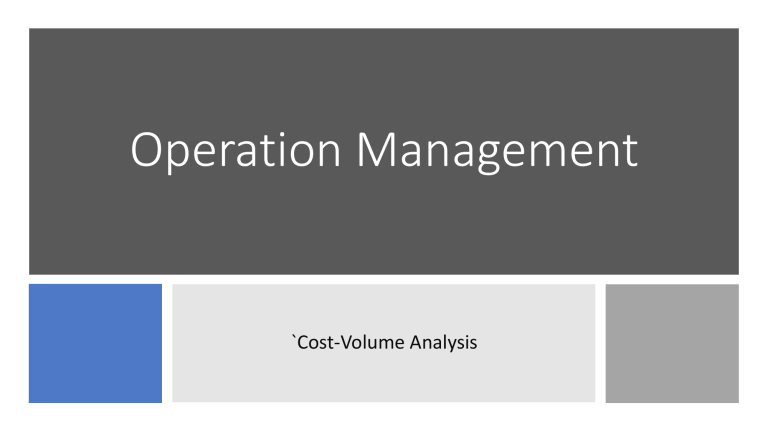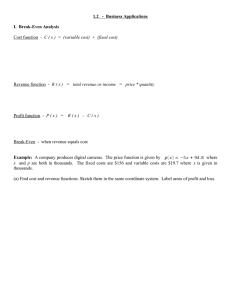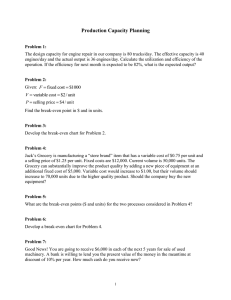Cost-Volume Analysis in Operations Management
advertisement

Operation Management `Cost-Volume Analysis Cost–Volume Analysis • Cost–volume analysis focuses on relationships between cost, revenue, and volume of output. • The purpose of cost–volume analysis is to estimate the income of an organization under different operating conditions. • It is particularly useful as a tool for comparing capacity alternatives. Cost–Volume Analysis • Use of the technique requires identification of all costs related to the production of a given product. • These costs are then designated as fixed costs or variable costs. • Fixed costs tend to remain constant regardless of volume of output. Examples include rental costs, property taxes, equipment costs, heating and cooling expenses, and certain administrative costs. • Variable costs vary directly with volume of output. The major components of variable costs are generally materials and labor costs. Total Costs • The total cost associated with a given volume of output is equal to the sum of the fixed cost and the variable cost per unit times volume: TC = FC + VC VC = Q * v • where v variable cost per unit. Figure 5.6A shows the relationship between volume of output and fixed costs, total variable costs, and total (fixed plus variable) costs. Total Revenue • Revenue per unit, like variable cost per unit, is assumed to be the same regardless of quantity of output. • Total revenue will have a linear relationship to output. • The total revenue associated with a given quantity of output, Q, is TR = R * Q Break-even point (BEP) • The volume at which total cost and total revenue are equal is referred to as the breakeven point (BEP) . • When volume is less than the break-even point, there is a loss; when volume is greater than the break-even point, there is a profit. The greater the deviation from this point, the greater the profit or loss. • Total profit can be computed using the formula P = TR - TC = R * Q - (FC + v * Q) • Rearranging terms, we have P = Q(R - v) – FC Break-even point (BEP) • The difference between revenue per unit and variable cost per unit, R v, is known as the contribution margin. • The required volume, Q, needed to generate a specified profit is Q= 𝑷+𝑭𝑪 𝑹 −𝒗 • A special case of this is the volume of output needed for total revenue to equal total cost. • This is the break-even point, computed using the formula 𝑭𝑪 𝑸𝑩𝑬𝑷 = 𝑹 −𝒗 Indifference point • Indifference point : the quantity at which a decision maker would be indifferent between two competing alternatives. 𝑸𝑩𝑬𝑷 = 𝑭𝑪 𝑹 −𝒗 • 𝑄𝐵𝐸𝑃 and FC has Positive relationship. • 𝑄𝐵𝐸𝑃 and R has Inverse/ negative relationship. • 𝑄𝐵𝐸𝑃 and contribution margin (V-R) has Inverse/ negative relationship. • 𝑄𝐵𝐸𝑃 and V has Positive relationship. Multiple Choices Questions 1. Maximum capacity refers to the upper limit of: A. inventories B. demand C. supplies D. rate of output E. finances Answer: D 2. At the break-even point: A. output equals capacity B. total cost equals total revenue C. total cost equals profit D. variable cost equals fixed cost E. variable cost equals total revenue Answer: B 3. What is the break-even quantity for the following situation? FC = $1,200 per week VC = $2 per unit Rev = $6 per unit A. 100 B. 200 C. 600 D. 1,200 E. 300 Answer: E 4. An alternative will have fixed costs of $10,000 per month, variable costs of $50 per unit, and revenue of $70 per unit. The breakeven point volume is: A. 100 B. 2,000 C. 500 D. 1,000 E. none of these Answer: C 5. For fixed costs of $2,000, revenue per unit of $2, and variable cost per unit of $1.60, the break-even quantity is: A. 1,000 B. 1,250 C. 2,250 D. 5,000 E. none of these Answer: D 6. Which of the following are assumptions of the break-even model? I. Only one product is involved. II. Everything that is produced can be sold. III. The revenue per unit will be the same regardless of volume. A. I only B. I and II only C. II only D. II and III only E. I, II and III Answer: E 7. If the fixed costs decrease, the 𝑸𝑩𝑬𝑷 will …. A. Increase B. Decrease C. Remain Constant Answer: B 8. If the Variable costs increase, the 𝑸𝑩𝑬𝑷 will …. A. Increase B. Decrease C. Remain Constant Answer: A 9. If the revenue decrease, the 𝑸𝑩𝑬𝑷 will …. A. Increase B. Decrease C. Remain Constant Answer: A True or False Questions 1. In cost-volume analysis, costs that vary directly with volume of output are referred to as fixed costs because they are a fixed percentage of output levels. FALSE 2. The break-even quantity can be determined by dividing the fixed costs by the difference between the revenue per unit and the variable cost per unit. TRUE 3. Capacity decisions are usually one-time decisions; once they have been made, we know the limits of our operations. FALSE 4. If the revenue doubled, the 𝑸𝑩𝑬𝑷 will be doubled also FALSE 5. There is an inverse relation between the Fixed costs and 𝑸𝑩𝑬𝑷 . False 6. There is a negative relation between the variable costs and 𝑸𝑩𝑬𝑷 . False 7. There is a positive relation between the Fixed costs and 𝑸𝑩𝑬𝑷 . True 8. There is a positive relation between the revenue and 𝑸𝑩𝑬𝑷 . False 9. If 𝒇𝒊𝒙𝒆𝒅 𝒄𝒐𝒔𝒕𝒔 𝒊𝒏𝒄𝒓𝒆𝒔𝒆 𝒕𝒉𝒆 𝑸𝑩𝑬𝑷 𝒘𝒊𝒍𝒍 𝒅𝒆𝒄𝒓𝒆𝒂𝒔𝒆 . False 10. If the revenue increase the 𝑸𝑩𝑬𝑷 𝒘𝒊𝒍𝒍 𝒊𝒏𝒄𝒓𝒆𝒔𝒆 . False Mariam Ashraf Teaching Assistant of Business and Management, Mansoura University






